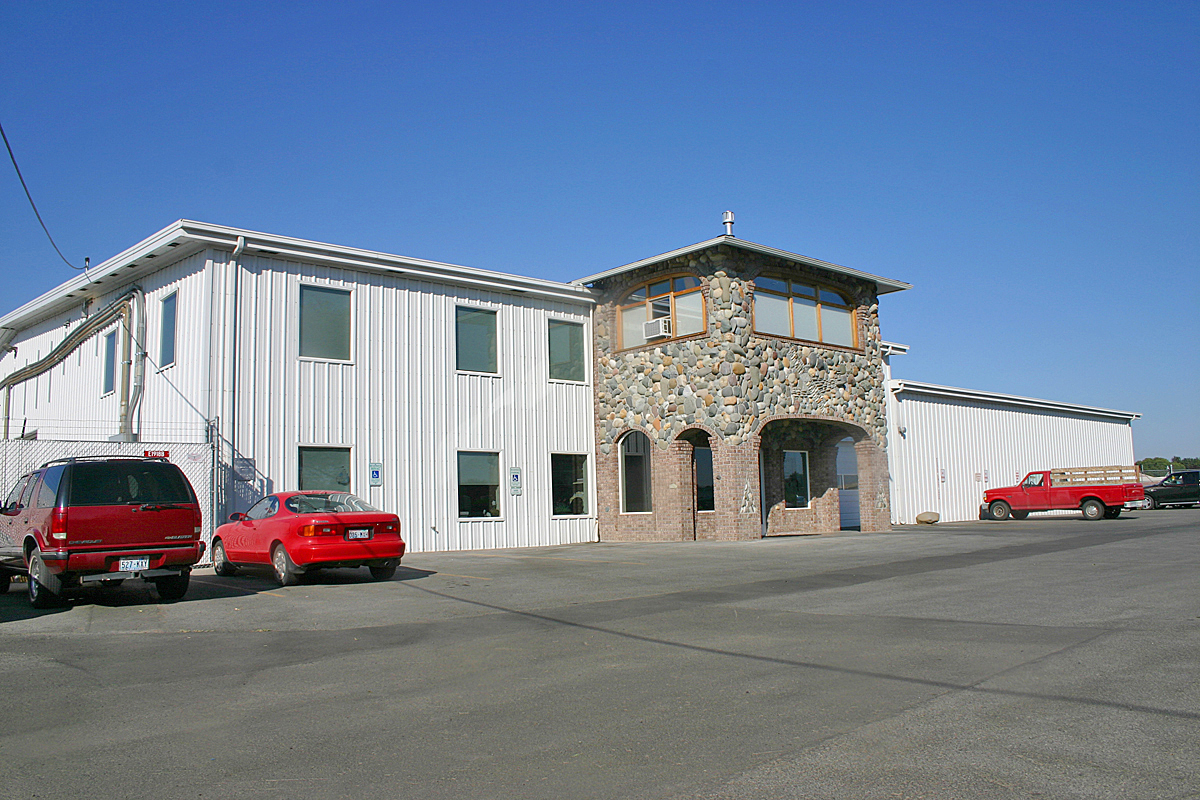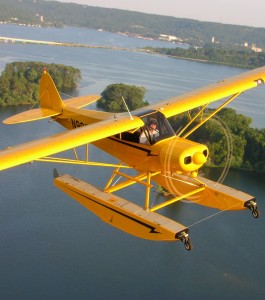By Terry Stephens
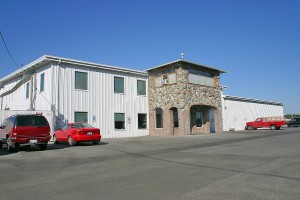
CubCrafters produces its Top Cub and new Sport Cub in this facility at Yakima Air Terminal/McAllister Field (YKM).
Aircraft sales are putting pressure on two aircraft manufacturers in Washington, Boeing in Seattle and CubCrafters in Yakima.
Boeing’s sales of its new 787 and other popular models have created a backlog of hundreds of planes that will take 25,000 workers years to produce. CubCrafters, by comparison, racked up sales of dozens of their new Sport Cub this year, producing a backlog that will keep dozens of employees busy for several months into 2007.
Executives at both companies are pleased with their successes and say they anticipate many more years of steady sales for their popular products. At CubCrafters, their enthusiasm hasn’t been dampened just because they’re the smallest manufacturer instead of the biggest.
“We’re the other airplane builder in the state, and we’re keeping busy, too,” said Todd Simmons, CubCrafters’ vice president, chief operating officer and the head of marketing and public relations. The company’s headquarters and factory are at the east end of Yakima Air Terminal/McAllister Field (YKM).
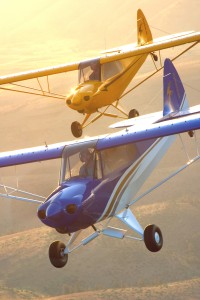
Both the Top Cub and the Sport Cub, made by CubCrafters, offer two paint styles: the traditional Cub yellow with the black lightning bolt, and a blue, white and gold scheme.
“One reason we’re busy is that we’re really three companies in one,” Simmons said. “The legacy of the company is 25 years of servicing and reconditioning Super Cubs. Thousands are still flying. We provide annual inspections and maintenance, new interiors, engine overhauls or whatever the need. Also, we do extensive restorations of older Cubs to give them new life. Our newest venture has been creating a production line for new aircraft. First, it was our CC-18 Top Cub in 2004. Then in 2005, we added our CC11-100 Sport Cub.”
The company’s Top Cub offers the ease and fun of flying for a new generation of pilots, he said, just as the original J-3 and the Super Cub captured the imagination and loyalty of previous generations. But Simmons noted that the Top Cub is designed to modern standards, including a more powerful 180-hp Lycoming engine and Garmin avionics that include optional color GPS navigation panels. The plane has the traditional Cub “rag and tube” airframe, with fabric stretched over metal, but the CubCrafters model is significantly strengthened, with modern materials that weren’t available when the original Cub design was launched in 1931.
“We reevaluated the company’s philosophy of just rebuilding Cubs,” he said. “We decided to begin producing our own instead, since Piper had quit making the plane in 1994. But, we knew we didn’t want to just build a new copy of the old Cub.”
Although the Top Cub, an improved version of the out-of-production Piper PA-18 Super Cub, continues to be a strong seller for the company, production has shifted, for the immediate future, primarily to the Sport Cub. Simmons said the company is delivering one Sport Cub a week, to try to meet market demand. With 75 of the “sport” models ordered so far, and only seven delivered, CubCrafters is working hard to chip away at the growing backlog.
Sport Cub offers nostalgia, performance
The new Sport Cub is making major changes in the company’s growth plans. It offers the nostalgia and simplicity of the legendary Cub, the improved performance found in modern aircraft and the perfect product for today’s rapidly expanding light-sport aircraft market.
“With the Sport Cub, we’re trying to do for the next 50 years of flying what the original J-3 did. So many people learned to fly in a Cub, it became an icon,” said Clay Hammond, CubCrafters’ national director of aircraft sales. “Our Sport Cub is like the second coming of the J-3. It encompasses the legacy of the J-3 and the first generation Super Cubs, all rolled into one, plus added performance and modern avionics.”
Like the new Volkswagen Beetle, originally popular from the 1930s to the 1960s and now in production again, the Sport Cub blends the mystic of nostalgic legacy with modern technology and performance. People still love Beetles because they’re easy and fun to drive, he said, and pilots love the new Cubs because they’re still easy and fun to fly, but comfort and performance are vastly improved.

CubCrafters’ factory is turning out a Sport Cub a week, to meet growing demand for the plane. Prices start around $100,000, plus options.
“When the Federal Aviation Administration’s recent sport pilot license was approved, we knew we needed to produce an entry for the light sport category,” said Hammond. “We kept the legacy of the plane intact, but we knew we had a blank slate to redesign the whole airplane. Also, we already had an experienced crew to take it into production. It was a natural step for us.”
CubCrafters’ advanced design for the Sport Cub preserves the style of the original Piper J-3 Cub, right down to the bright yellow paint with the familiar black lightning bolt along the fuselage. But, for those who want the looks of the plane updated, the company offers a blue, white and gold-striped version.
“The Sport Cub is ideal as a trainer and for the light-sport aircraft market. It’s also a ultimate sport utility plane, still for fun flying, but also for bush flying, landing on lakes with floats, or whatever you want,” Hammond said.
Pilots in Alaska and elsewhere have already placed orders for Sport Cubs with flaps and larger tires, for short landing field service in remote areas.
Along with preserving the original Cub’s reputation for easy handling, some of the newer features of the Sport Club include the largest door and cabin area in its class, large cargo space behind the seats and an optional all-digital, flat-screen GPS and avionics system by Garmin.
The Sport Cub, with an empty weight of 825 pounds and gross weight of 1,320, offers up to 351 pounds of payload, with a full fuel tank. Providing more room than usual, the cabin (30-inch width and 52-inch height) is designed to make the flying experience more comfortable. The cabin is four inches wider than the Super Cub, for both pilot and copilot. A gravity feed fuel system eliminates header tanks and a fuel pump. It has dual flight controls and toe brakes, as well as leather seats and dual swing-out windows.
With a length of 23 feet, 3 inches, and a height of 8 feet, 4 inches, the plane has a wingspan of 34 feet, 8 inches, and is sized to combine high-performance with the ability to travel almost anywhere. Powered by a Continental O-200, 100-hp engine, with a Sensenich wood-composite propeller, the Sport Cub can take off within 250 feet, climb at 800 feet per minute and hit a top speed of 121 miles per hour.
Cruising at 105 mph burns around 4.5 gallons per hour, providing 2.5 hours flying time and a 250 mile range. The optional second tank offers five hours flying time, with a 500 mile range. The plane stalls at 40 mph and needs as little as 200 feet for a landing ground roll. Those performance ratings assume a 1,320 pound gross weight at sea level, with no wind, according to CubCrafters’ statistics.
Like the original Cubs, Taylorcrafts and Aeroncas of the 1930s and ’40s, today’s Sport Cub is designed for low-and-slow, simplified VFR flying that provides the exhilaration of flight found in the most popular small planes of more than 50 years ago, company executives said. But today’s aircraft package includes the intangible ingredient pilots really want: the fun and peacefulness of flight, but in a safer, more comfortable design than the originals.
“No Piper parts are in the planes, but the early Cub feel of flying is there. The plane’s iconic popularity, combined with the new Sport Cub’s certification for the FAA’s sport pilot license, is giving us that backlog of orders,” Simmons said.
CubCrafters has always been about Cubs
Jim Richmond founded CubCrafters in 1980, and remains president and CEO. A 1978 graduate of Moody Aviation’s flight school in Tennessee, he earned a commercial license, instrument rating and airframe and power plant license within a few years after graduation. His 5,000-plus hours in his logbook include earning ratings in seaplanes and multi-engine aircraft.
A few years after college, he refurbished and sold three Super Cubs, the first of more than 500 he’s owned or rebuilt since then. Rebuilding the planes sparked Richmond’s ideas for simple improvements to the planes. The ideas worked so well, he incorporated them into a new design for the old aircraft.
He put all of his experience into forming CubCrafters, focusing on rebuilding and servicing Piper Aircraft’s popular Super Cubs. His restorations returned the planes to their original, and often better, condition. In 1998, the FAA approved CubCrafters’ launch of an improved version of the Super Cub, built entirely with new parts. By 2004, he had sold 75 planes to the U.S. Border Patrol, the U.S. Air Force Academy and numerous private pilots.
Taking the next step beyond modifying the Super Cub, Richmond designed and tested his own version of the popular plane. He earned FAA certification in 2004, and put his new Top Cub into production. But within months, even with orders for more than 50 models of the Top Cub already on his books, he found himself responding to the newly approved light-sport aircraft market with a whole new aircraft venture, his Sport Cub.
Certified for production in 2005, the Sport Cub met not only FAA standards, but also Richmond’s own standards for a high-performance aircraft that also fit sport-plane parameters. The design of the new plane reflected the influence of Richmond’s years of experience, innovations and improvements on Cubs, including his own Top Cub. By the end of 2006, both planes were in such demand that total orders were approaching $12 million. The Top Cub’s base price is around $160,000. The Sport Cub’s window sticker starts at around $100,000. Options range from a second gas tank to a Garmin glass cockpit.
Included in those prices is that intangible element of aviation history that contributes so much to the planes’ success and popularity: the design and performance of the original J-3 Cub and Super Cub.
Piper Cub was first a Taylorcraft
The history of the Cub spans 78 years of aviation history, an enviable legacy for any aircraft. Clarence Gilbert Taylor designed the plane in 1928 in Rochester, N.Y., and then formed Taylor Brothers Aircraft Corp. to build it. After Gordon A. Taylor was killed in the crash of an early version of the plane, Gilbert moved the plant to Pennsylvania and continued its development until the depression forced him into bankruptcy in 1930.
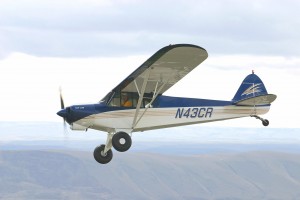
Many features of the traditional Cub are upgraded or new, including an optional blue, white and gold paint style.
Pennsylvania oilman William Piper heard about the company and used his fortune to buy its assets. He formed Taylor Aircraft Co., with C.G. Taylor as chief engineer. Piper wanted to produce a simple, economic training plane.
Perfecting his earlier design, Taylor created the E-2. Its first engine, a Brownbach Tiger Kitten, was hopelessly underpowered, at only 20-hp, and soon yielded to a 37-hp Continental A-40 in the second E-2. The Tiger Kitten engine was used just long enough to become the namesake for that second plane, the Cub, which was certified June 15, 1931.
Piper’s company continued to build the E-2 until 1936, producing 348 planes. Among the twists and turns in the Cub’s history was employee Walter Jamouneau, who redesigned the plane while Taylor was out with an illness. The first version of the J-2, which flew early in 1935, included a closed cockpit, a new tail shape, rounded wingtips, a new engine cowling and a wider landing gear.
Unhappy with the changes, Taylor left the company to form a new firm, the Taylor-Young Airplane Co. By late 1937, the Taylor Aircraft Co. became Piper Aircraft Corp., manufacturing the firm’s latest improvement on the Taylor and Jamouneau designs—the J-3 Cub, priced at $1,325. It proved to be so stable and safe that it became a popular trainer, as well as an easy plane to handle for recreational flying. In the late 1930s, when most civilian aircraft in its class were selling for $10,000 or more, the Cub could be had for less than $2,000. Aviation records show that thousands of the J-3s were sold before the United States entered World War II.
During the war years, all J-3 production was for the Army Air Force, including a military liaison aircraft known as the L-4, and a Navy version, the NE-1. After the war, according to records of the plane’s heritage, new civilian models of the J-3 became the PA-11 Cub Special, with a 65-hp Continental C-90, followed by the PA-12 Super Cruiser, with two seats in front and one in back, and the PA-14 Family Cruiser with four seats.
The PA-18 Super Cub, with a 135-hp engine, attracted the attention of bush pilots, who wanted it for much more than recreational flying. The Cub soon became a popular working airplane. With oversized tundra tires or floats for operating in Alaska’s vast domain, the Super Cub’s price also moved more towards super itself, reaching around $47,000 in the late 1970s and over $100,000 in the 1980s.

A Sport Cub in a modern paint design, instead of the Cub’s traditional yellow, lands on a grassy field near Yakima, Wash.
Over many decades, Piper produced more than 20,000 models of the J-3, along with 8,000 of the higher performance Super Cubs. But in 1994, the company ceased production of the popular aircraft.
Other “new Cubs” are flying
Although CubCrafters appears to be the leading manufacturer of the Cub lineage today, building on nearly three decades of experience in repairing and restoring original Cubs, the broad market developing for light sport planes has attracted other ventures.
Two years ago, in Sulphur Springs, Texas, the newly formed American Legend Aircraft Co. began producing the Legend Cub, its own upgraded version of the original J-3 Cub, but designed to meet light-sport aircraft certification standards.
Even new models of the Taylorcrafts of the 1930s and ’40s, cousins of sorts in the family tree of the Piper Cub, are flying again, along with hundreds of original Taylorcrafts built during those years.
The Taylorcraft Co. went into bankruptcy in 1946. Several different owners tried to resurrect it, and produced limited numbers of Taylorcraft airplanes into the late 1950s. From 1970 through 1985, a factory in Alliance, Ohio, produced nearly 200 of the planes. A new firm opened in Lock Haven, Penn., the home of the famous Piper Airplane Co., and built Taylorcrafts until 1992.
Then, in 2003, pilot and airplane enthusiast Harry Ingram bought the assets and rights to build Taylorcrafts, spent two years preparing a factory in Brownsville, Texas, and is now building new planes under the old Taylorcraft name.
For more information, visit [http://www.cubcrafters.com], email Clay Hammond at clayh@cubcrafters.com, or call 509-248-9491.











